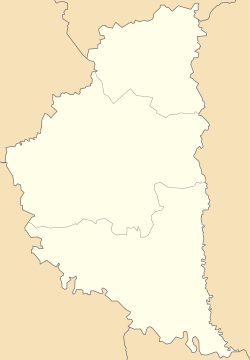Kozova
Kozova
Козова Kozowa | |
|---|---|
 | |
 Flag  Coat of arms | |
 Kozova Location of Kozova in Ternopil Oblast | |
| Coordinates: 49°25′55″N 25°09′34″E / 49.43194°N 25.15944°ECoordinates: 49°25′55″N 25°09′34″E / 49.43194°N 25.15944°E | |
| Country | |
| Oblast | |
| Raion | Ternopil Raion |
| Area | |
| • Total | 18 km2 (7 sq mi) |
| Population (2020) | |
| • Total | 8,937 |
| • Density | 500/km2 (1,300/sq mi) |
| Postal code | 47600 |
| Area code(s) | +380 3547 |
| Climate | Dfb |
Kozova (Ukrainian: Козова; Polish: Kozowa; Russian: Козо́ва) is an urban-type settlement in Ternopil Raion, Ternopil Oblast (province) of western Ukraine, in the area historically known as Galicia, 16 km (10 mi) east of Berezhany, some 30 km (19 mi) west of Ternopil and c. 100 km (62 mi) southeast of Lviv. It hosts the administration of , one of the hromadas of Ukraine.[1] The settlement is situated beside a lake on the Koropets River (“little carp”). There is presumption that the name Kozova comes from the Ukrainian word koza (goat), though other possible sources exist. The Weingarten family emigrated from Kozova to New York at the turn of the century and later became successful in New York and Canadian real estate (Minnie and Sam Weingarten).[2] Population: 8,937 (2020 est.)[3]
History[]
During 1350-1772 and again in 1919-1939 it was part of Poland. The first partition of Poland in 1772 attributed Galicia to the Habsburg Monarchy. See more details in the article Kingdom of Galicia and Lodomeria. The Polish name Kozowa was used until 1939.

Kozova was part of the Soviet Union in the years 1939-1991, interrupted by the period of German occupation in 1941-1944.
The population in 1939 was about 5,000, including many Poles and Jews. Upon the German occupation following Operation Barbarossa, the extermination of the town's Jewish population began. About 1.000 Jews were deported from Kozova to the Belzec death camp on 21 September 1942. In April 1943, another 1,000 Kozova Jews were shot by Germans, and in June 1943, 400 more Jews were executed by the Nazis. All are buried in mass grave in Kozova. After the war's end, the remaining population is exclusively Ukrainian, with only a few Poles, Jews and Russians.
The Weingarten family influential in Canadian and New York real estate immigrated from Kozova at the turn of the century.
Until 18 July 2020, Kozova served as the administrative center of Kozova Raion. The raion was abolished in July 2020 as part of the administrative reform of Ukraine, which reduced the number of raions of Ternopil Oblast to three. The area of Kozova Raion was merged into Ternopil Raion.[4][5]
Economy[]
Kozova Dairy is a major dairy enterprise, with a butter plant that processes 50 tons of milk daily. AGRO Ltd. from Lviv holds majority positions in Kozova Dairy. The town also is known for the sugar refinery, one of the main ones of the region.[6]
Communications[]
The telephone code for Kozova and the Kozova district is +380 3547. Kozova telephone information service (called Dovidkova in Ukrainian): +380 3547 21222
Monuments[]
- Ukrainian Greek-Catholic Church Church of Assumption of Theotokos (1885), saint Peter and Paul (2007), saint Basil Great (2001).
- Belfry of Holy Spirit Church in village of Koniukhy, Kozova district.
- Holy Spirit Church in village of Koniukhy, Kozova district.
- Monument to Taras Shevchenko (classical Ukrainian writer and poet) in front of Kozova Children Arts School (Khudozhnya Shkola)
See also[]
- Shtetl, a small town with a large Jewish population in pre-Holocaust Central and Eastern Europe.
References[]
- ^ "Козовская громада" (in Russian). Портал об'єднаних громад України.
- ^ http://jri-poland.org/psa/kozowasurn.htm
- ^ "Чисельність наявного населення України (Actual population of Ukraine)" (PDF) (in Ukrainian). State Statistics Service of Ukraine. Retrieved 30 September 2020.
- ^ "Про утворення та ліквідацію районів. Постанова Верховної Ради України № 807-ІХ". Голос України (in Ukrainian). 2020-07-18. Retrieved 2020-10-03.
- ^ "Нові райони: карти + склад" (in Ukrainian). Міністерство розвитку громад та територій України.
- ^ Volodymyr Kubijovyč, ed. (1984). Encyclopedia of Ukraine, Volume 5 (Repr. ed.). Toronto: University of Toronto Press. p. 201. ISBN 978-0-8020-3362-8.
External links[]
- Urban-type settlements in Ternopil Oblast
- Holocaust locations in Ukraine
- Populated places in Kozova Raion

